Bunions
Bunion Treatments
for Niagara Falls, NY & Beyond
Feet are a vital part of the body’s structure, as they provide necessary support and balance to perform daily activities. Proper foot care is crucial to ensure the body stays healthy. A lot of people struggle with common foot problems like bunions. These bumps are often caused by wearing tight or narrow shoes. In some cases, bunions can develop because of a medical condition. Without proper care, these bumps cause havoc and could damage the foot's integrity.
Finding an experienced foot doctor for a bunion treatment is key to keeping your feet healthy. At Dr. Richard Sawicki, our podiatrist strives to develop comprehensive treatment plans for each patient that comes through the door. No matter the severity of your foot issue, we will reduce your discomfort by finding the right bunion treatment for you.

What is a Bunion?
A bunion forms when the big toe bends toward the second toe. In some cases, smaller bunions can develop on the joint of the pinky toe. Bunions cause the skin where the big toe joins the foot to become inflamed and callused. Over time, this area may stick out and become hard.
What Causes a Bunion to Form?
While ill-fitting shoes like high heels are one of the main causes of bunions, there are several other factors that could cause them to develop. If you have any of the following risk factors, proper foot care is crucial to preventing bunions from forming. Wearing proper shoes that are comfortable and spacious will prevent the bones in the forefoot from shifting. Browse the following section to see some of the risk factors that increase people's chances of developing this foot problem.
Genetics
Bunions tend to run in families since the overall foot structure is hereditary. Having family members with bunions puts people at a higher risk for developing similar problems. Deformities that were present at birth may also cause foot problems to develop in the future.
Medical Conditions
Certain types of arthritis such as rheumatoid arthritis are associated with bunion formation. Even without the presence of bunions, people with this inflammatory condition have a higher risk of developing bunions.
What are the Common Symptoms & Signs of a Bunion?
People walk on their feet every day, which is why having a bunion can add even more stress on the feet. There are many different types of foot problems, which is why noticing the signs of a bunion is crucial to preventing it from worsening. Check out the following section to see some of the common symptoms of a bunion.
Bulging Bump
A bunion is easy to spot once it’s developed. It will appear as a bulging bump at the base of the big or pinky toe. The area may appear to be hard to the touch, red, and inflamed.
Other Toes
Once a bunion has developed, it causes some of the other toes to rub together. This can lead to the formation of corns or calluses to form in the area where the toes are rubbing.
Pain
A bunion can cause extreme soreness and pain. The pain can be ongoing or come and go throughout the day. The pain and soreness can lead to limited mobility with the affected foot.
What are the Different Types of Bunion Treatment Options?
There are a variety of bunion treatments available that have helped people find relief. Whether the bunion just formed or has been there for a while, proper care is crucial to keeping the foot healthy. At-home bunion treatments are a great place to start if you can’t get to the foot doctor right away. While they may help you achieve some relief, a foot doctor will evaluate the area and suggest a bunion treatment to help eliminate your symptoms.
At-Home Care
After a bunion has formed, it’s crucial that you change out the shoes you’ve been wearing. Find a pair of shoes that are comfortable and have enough space for your toes. Inserting padding in the shoe around the affected area can help to ease pain while you're on your feet throughout the day. Using shoe inserts will also prevent the bunion from worsening. Taking over-the-counter pain relievers and using heating pads or ice packs on the affected area can help to ease the discomfort.
Devices
If at-home bunion treatments fail, the care of a foot doctor is necessary. Depending on the severity of the bunion the doctor may use a device to separate the big toe from the second toe. For larger and more serious bunion cases, this option may not work best.
Surgery
Depending on the size and severity of a bunion, a foot doctor may have to perform surgery. There are a variety of different techniques a foot doctor may perform during surgery including removing the swollen tissue around the toe, removing part of the bone to straighten the toe, realign one or more bones to correct the angle in the toe’s joint, and permanently joining the bones of the toe. Surgery may be the only bunion treatment available to treat a severe case. As with any surgery, full recovery can take anywhere from weeks to months.
Contact Our Foot Doctor in Niagara Falls, NY for Quality Bunion Treatment Options
If you’re struggling with a bunion, it’s time to talk with our foot doctor about treatment options. At Dr. Richard Sawicki, we’ve had years of experience in providing bunion treatments for residents across Niagara Falls, Lockport, NY and the surrounding communities. Have no doubt our team will be able to help you manage and treat the bunion properly. To schedule an appointment for a bunion treatment,
contact our foot doctor!
Dr. Richard Sawicki
8657 Buffalo Avenue | Niagara Falls, NY 14304 • Phone: (716) 283-3338
Web Design by LocalEdge , all rights reserved
